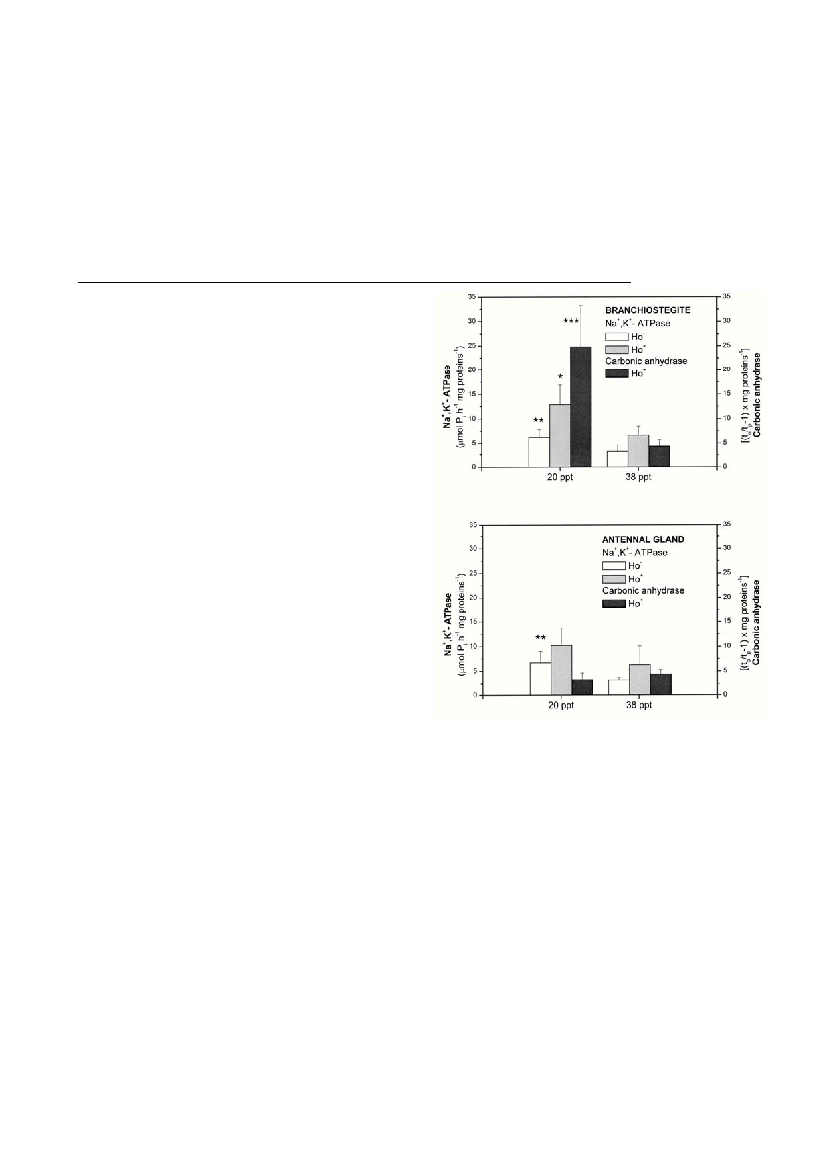Rapp. Comm. int. Mer Médit., 36,2001
204
There is a lack of information on the biochemical aspects of adap-
t
ivness to various seawater osmoconcentration in commercially
important Adriatic lobster Homarus gammarus. The osmoregulatory
role of the branchiostegite, as a epidermal tissue underlying carapace
in the region of the trichobranchiate chamber as well as these of anten-
nal gland is unknown. We have studied effect of 38 ppt seawater (SW)
and 20 ppt dilute seawater (DSW) on the branchiostegite and antennal
gland activities of the Na,K-ATPase and carbonic anhydrase (CA),
enzymes which are respectively involved in the primary-driven Na
pump, and in supply of the carriers for secondary active transport of
osmolytes.
Preparation of the homogenates of branchiostegite and antennal
gland and measurements of the enzymes was carried out by modified
procedures described in details (1, 2). The Na,K-ATPase was mea-
sured in native homogenates and saponin treated homogenates of the
branchiostegite (1). CA was determined following the rate of hydra-
tion and dehydration of CO2 comparing the uncatalysed (slightly
buffered saline) and catalysed (branchiostegite homogenate in slightly
buffered saline) reaction times of the enzyme (3). The total carbonic
a
n
hydrase was measured in detergent Tryton-100 treated
homogenates. In the lobsters two weeks acclimated to DSW, the Na,K-
ATPase activity in the branchiostegite homogenates (6.2 mmol Pi h-1
per mg protein) and in saponin treated homogenates (12.8 mmol Pi h-
1 per mg protein) was 1.96 and 1.94 times higher of the respective
activities in the SW acclimated lobsters (Fig.1.). Moreover, under the
identical experimental conditions CA activity in the branchistegite
was 5.6 –fold over the seawater acclimated lobsters. When lobsters
acclimated to DSW the increased Na,K-ATPase activity are consistent
with the previously published results on the enzyme activation in tri-
chobranchiate gills and epipodites of the osmoregulating lobster
Homarus gammarus (2, 4) and no activation in stenohaline conform-
ing Crustacea occur (5). Enzymes activation was followed by keeping
osmoconcentration gradient between the haemolymph and hypoos-
motic DSW. Increased activity of CA in DSW in gills (6) and bran-
chiostegite (this study) supporting the conclusion that branchiostegite
CA plays important role in ion regulation processes (Fig.1). However,
when lobster acclimated to DSW, there was no activation of the CA in
the antennal gland homogenates of the SW and DSW acclimated lob-
sters. Slightly increased Na,K-AT
Pase in the antennal gland
homogenates in DSW-acclimated lobsters, suggests probably active
role in divalent ions regulation and in elimination of nitrogenous waste
products.
References
1- Lucu, C. and Flik,G. 1999. Na-K-ATPase and Na
+
/Ca
2+
exchange
activities in gills of hyperregulating Carcinus maenas.Am. J. Physiol.
27,: R490-R499.
2- Lucu, C and Decescovi,M. 1999. Osmoregulation and branchial Na,K-
ATPase in the lobster I acclimated to dilute seawater.J. Exp. Mar. Biol.
Ecol.,234: 291-304.
3- Böttcher K., Siebers D. and Becker W., 1990. Localization of carbonic
anhydrase in the gills of Carcinus maenas.Comp. Biochem. Physiol.,
96B: 243-246.
4- Flik G. and Haond C., 2000. Na and Ca pumps in the gills, epipodites
and branchiostegites of the European lobster Homarus gammarus: effects
of dilute seawater.J. Exp. Biol.,203: 213-220.
5 - Lucu C. Devescovi M. Skaramuca B. and Kozul V., 2000. Gill Na,K-
ATase in the spiny lobster Palinurus elephasand other marine
osmoconformers. Adaptivneness of enzyme from osmoconformity to
hyperregulation.J. Exp. Mar. Biol. Ecol.,246: 163-178.
6- Wheatly M.G. and Henry R., 1987. Branchial and antennal gland
Na/K dependent ATPase and carbonic anhydrase activity during salinity
acclimation of the euryhaline crayfish Pacifastacus leniusculus. J. exp.
Biol., 133, 73-86.
ENZYMES INVOLVED IN OSMOLYTE TRANSPORT PROCESSES IN THE ADRIATIC LOBSTER
HOMARUS GAMMARUS
Dijana Pavicic-Hamer*, Massimo Devescovi and Cedomil Lucu
Institute Rucer Bockovic, Center for Marine Research, Rovinj, Croatia - pavicic@cim.irb.hr
Abstract
Transport related enzymes Na,K-ATPase and carbonic anhydrase (CA) were studied in the branchiostegite and antennal gland of the
commercially important Adriatic lobsters Homarus gammarus acclimated to seawater (SW; 38 ppt) and dilute seawater (DSW; 20ppt) . In
homogenates of branchiostegite from DSW-acclimated lobsters, specific activities of Na,K-ATPase was about 2- fold higher of the native
(3.2 mmol Pi h-1 per mg protein) and saponin treated homogenates ( 6.6 mmol Pi h-1 per mg protein) than those of the SW-acclimated
lobsters. In DSW –acclimated Homarus, CA activity of branchiostegite homogenates was 5.6-fold of activities reported in SW (4.42 U per
mg proteins). In DSW specific activity of the Na,K-ATPase in antennal gland native homogenates was 2- fold increased of the SW lobsters
(3.2 mmol Pi h-1 per mg protein). However, the CA in antennal gland was not activated keeping Enhanced activity of branchiostegites CA
and not these in the antennal gland when acclimated to DSW suggest different strategies of the enzyme fitting in these osmoregulatory
tissues.
Key words. Lobster, Homarus gammarus, branchiostegite, antennal gland, Na,K-ATPase, Carbonic anhydrase
Fig.1. Na,K-ATPase and carbonic anhydrase activities in bran-
chiostegite and antennal gland of the lobster Homarus gam-
marusacclimated to seawater (38ppt) and dilute seawater
(20ppt).
H-0 = native homogenate; H+0 = saponin (Na,K-ATPase), and
Tryton-100 (CA) treated homogenates. Mean values for 4-6 indi-
vidual samples are given, error bars indicated SE. Asterix denote
Student's t-test a value significantly different from the seawater
value

